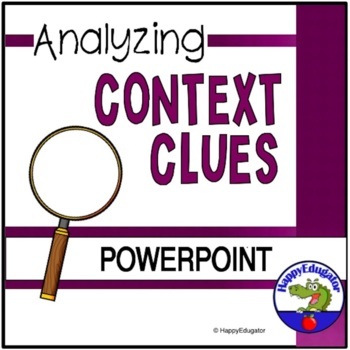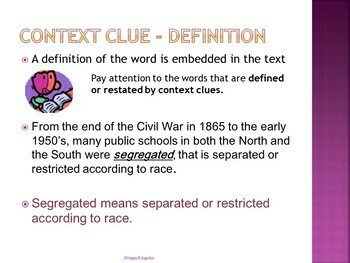Context Clues PowerPoint
- PPTX
- Microsoft OneDrive
Description
This is a context clues vocabulary activity for upper elementary or middle grades. No prep. This Context Clues PowerPoint helps students figure out unknown words in text by analyzing the context clues. Build vocabulary and reading comprehension by teaching these common strategies for using context clues. This PowerPoint explains five different common context clues: definition, synonym, antonym, example, and inference. Practice slide at the end with answer key is a good interactive review activity. Includes a printable student copy of the practice slide which you can use as a worksheet or quiz. Good for test prep! Please see full preview. Note: animations do not show in the preview.
Did you know that you can use PowerPoints like this in video conferencing or Zoom for remote learning? You can share with your students in OneDrive and in Microsoft Teams, too. Just view in Slideshow mode. You can also upload to Google Drive and save as Google Slides, and it will automatically convert and you can use it in Google Classroom. It is editable and easy to make adjustments if necessary.
This is an excellent lesson to use during summer school or for reading intervention to help struggling students read with better understanding. These strategies are useful for students who have a difficult time with tier two vocabulary words.
You may also like:
Reading - Good Readers Posters
Reading Strategies - Active Reading Strategies Concept Map
CCSS.ELA-Literacy.RL.4.4 Determine the meaning of words and phrases as they are used in a text, including those that allude to significant characters found in mythology (e.g., Herculean).
CCSS.ELA-Literacy.RL.5.4 Determine the meaning of words and phrases as they are used in a text, including figurative language such as metaphors and similes.
CCSS.ELA-Literacy.RL.6.4 Determine the meaning of words and phrases as they are used in a text, including figurative and connotative meanings; analyze the impact of a specific word choice on meaning and tone
CCSS.ELA-Literacy.L.7.4a Use context (e.g., the overall meaning of a sentence or paragraph; a word’s position or function in a sentence) as a clue to the meaning of a word or phrase.
CCSS.ELA-Literacy.L.8.4a Use context (e.g., the overall meaning of a sentence or paragraph; a word’s position or function in a sentence) as a clue to the meaning of a word or phrase.
Follow me HERE to get notified of updates, sales, free resources, and new products. All new products are 50% off for 48 hours.
© Deborah Hayes aka HappyEdugator. For classroom and homeschool use. Your purchase buys one license. You may purchase extra licenses at a discount.





